1998 PONTIAC BONNEVILLE rear view mirror
[x] Cancel search: rear view mirrorPage 105 of 395
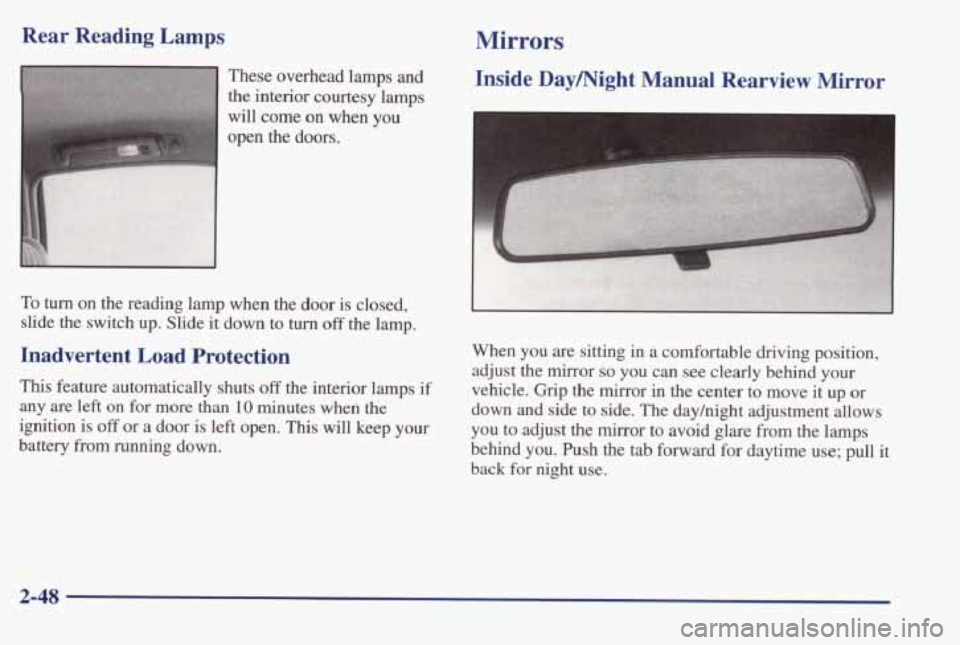
Rear Reading Lamps
These overhead lamps and
the interior courtesy lamps
will
come on when you
open the doors.
To turn on the reading lamp when the door is closed,
slide the switch
up. Slide it down to turn off the lamp.
Inadvertent Load Protection
This feature automatically shuts off the interior lamps if
any are left on for more than 10 minutes when the
ignition is off or a door is left open. This will keep your
battery
fiom running down.
Mirrors
Inside Daymight Manual Rearview Mirror
When you are sitting in a comfortable driving position,
adjust the mirror
so you can see clearly behind your
vehicle.
Grip the mirror in the center to move it up or
down and side to side. The dayhight adjustment allows
you to adjust the mirror to avoid glare from the lamps
behind you. Push the tab forward for daytime use; pull it
back
for night use.
2-48
Page 106 of 395
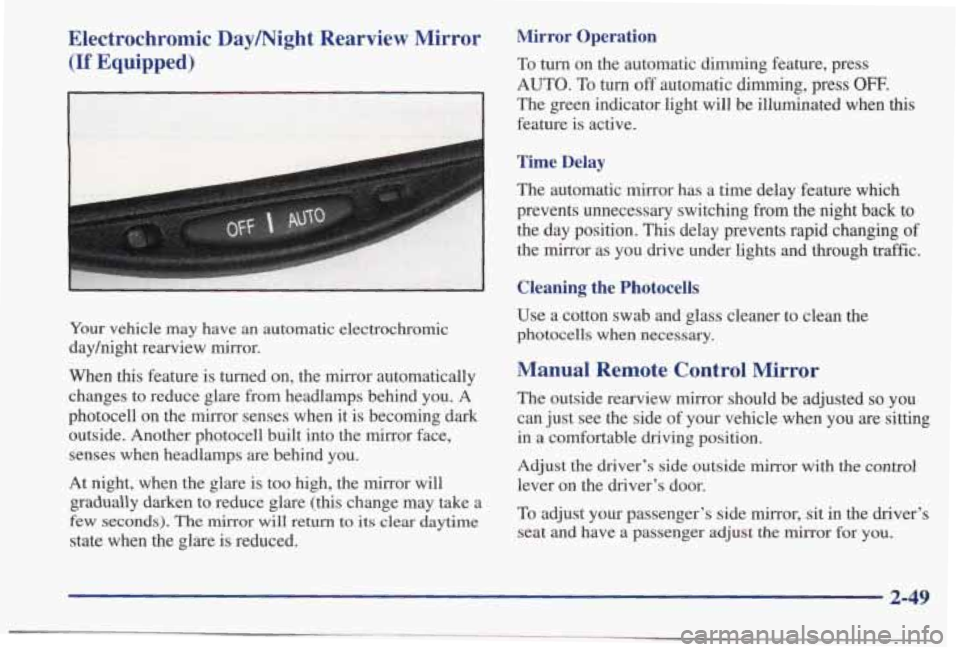
Electrochromic Daymight Rearview Mirror
(If Equipped)
-1 cc- I
Your vehicle may have an automatic electrochromic
dayhight rearview mirror.
When
this feature is turned on, the mirror automatically
changes to reduce glare from headlamps behind you. A
photocell on the mirror senses when it
is becoming dark
outside. Another photocell built into the mirror face,
senses when headlamps are behind you.
At night, when the glare is too high, the mirror will
gradually darken to reduce glare
(this change may take a
few seconds). The
mirror will return to its clear daytime
state when the glare is reduced.
Mirror Operation
To turn on the automatic dimming feature, press
AUTO. To turn off automatic dimming, press OFF.
The green indicator light will be illuminated when this
feature is active.
Time Delay
The automatic mirror has a time delay feature which
prevents unnecessary switching
from the night back to
the day position. This delay prevents rapid changing of
the mirror as you drive under lights and through traffic.
Cleaning the Photocells
Use a cotton swab and glass cleaner to clean the
photocells when necessary.
Manual Remote Control Mirror
The outside rearview mirror should be adjusted so you
can just see the side of your vehicle when you are sitting
in a comfortable driving position.
Adjust the driver’s side outside mirror with the
control
lever on the driver’s door.
To adjust your passenger’s side mirror, sit in the driver’s
seat and have a passenger adjust the
mirror for you.
2-49
Page 107 of 395
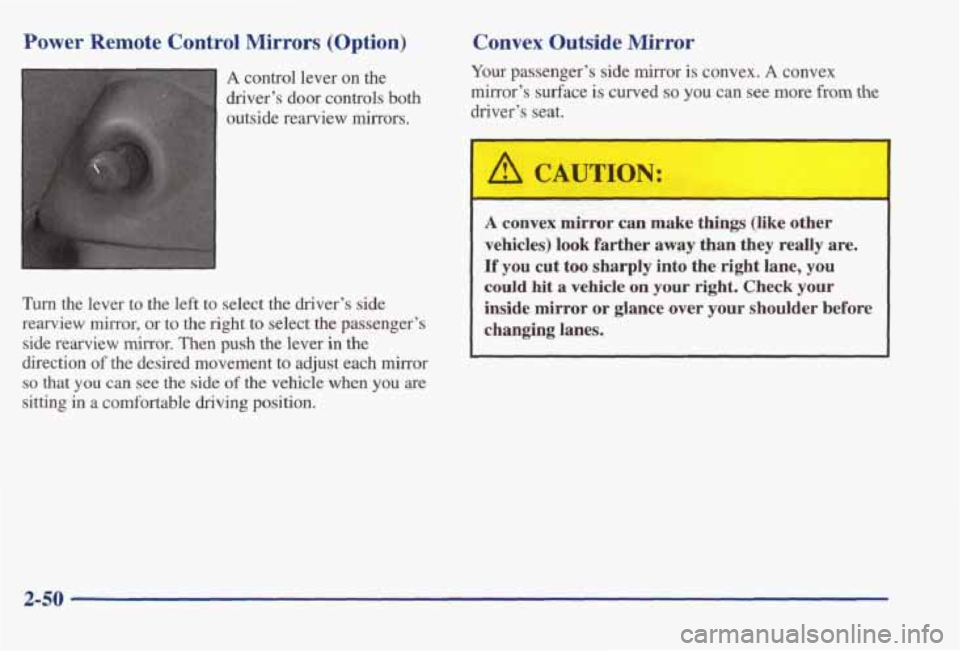
I
Power Remote Control Mirrors (Option)
A control lever on the
driver’s door controls
both
outside rearview mirrors.
Turn the lever to the left to select the driver’s side
rearview mirror, or to the right
to select the passenger’s
side rearview mirror. Then
push the lever in the
direction
of the desired movement to adjust each mirror
so that you can see the side of the vehicle when you are
sitting in a comfortable driving position.
Convex Outside Mirror
Your passenger’s side mirror is convex. A convex
mirror’s surface is curved
so you can see more from the
driver’s seat.
I A CAUTION:
A convex mirror can make things (like other
vehicles) look farther away than they really are.
If you cut too sharply into the right lane, you
could hit a vehicle on your right. Check your
inside mirror or glance over your shoulder before changing lanes.
2-50
Page 189 of 395
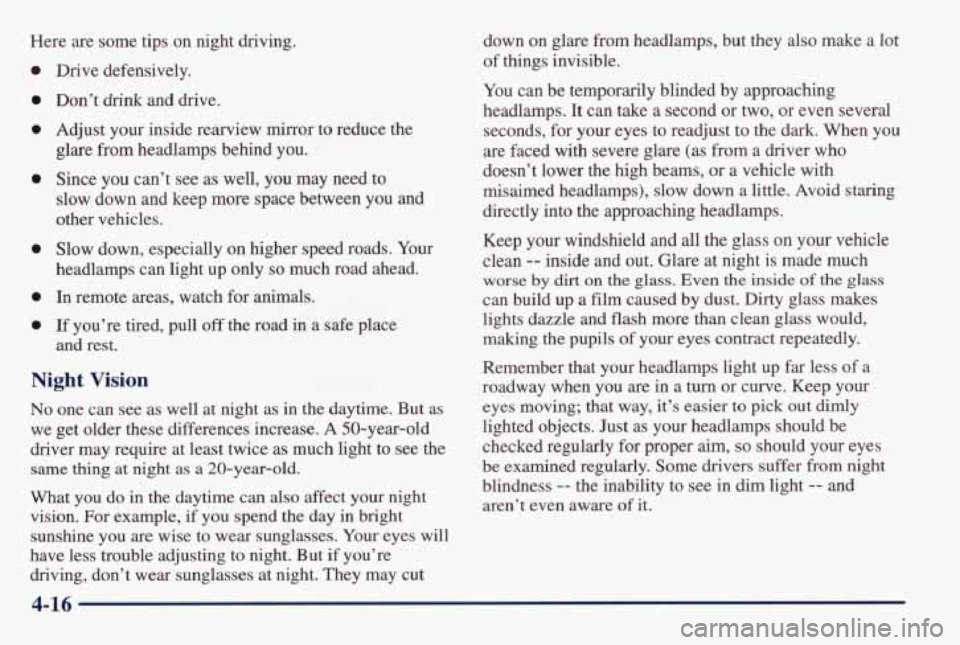
Here are some tips on night driving.
0 Drive defensively.
0 Don’t drink and drive.
0 Adjust your inside rearview mirror to reduce the
glare
from headlamps behind you.
0 Since you can’t see as well, you may need to
slow down and keep more space between
you and
other vehicles.
0 Slow down, especially on higher speed roads. Your
headlamps can light up only
so much road ahead.
0 In remote areas, watch for animals.
0 If you’re tired, pull off the road in a safe place
and rest.
Night Vision
No one can see as well at night as in the daytime. But as
we get older these differences increase.
A SO-year-old
driver may require at least twice as much light to see the
same thing at night as a 20-year-old.
What you do
in the daytime can also affect your night
vision. For example, if you spend the day in bright
sunshine you are wise to wear sunglasses. Your eyes will
have less trouble adjusting to night. But
if you’re
driving, don’t wear sunglasses at night. They may cut down
on glare from headlamps, but they also make a
lot
of things invisible.
You can be temporarily blinded by approaching
headlamps. It
can take a second or two, or even several
seconds, for your eyes to readjust to the dark. When you
are faced with severe glare (as
from a driver who
doesn’t lower the high beams, or a vehicle with
misaimed headlamps), slow down a
little. Avoid staring
directly into the approaching headlamps.
Keep your windshield and
all the glass on your vehicle
clean
-- inside and out. Glare at night is made much
worse by dirt on the glass. Even the inside of the glass
can build up a film caused by dust. Dirty glass makes
lights dazzle and flash more
than clean glass would,
making the pupils of your eyes contract repeatedly.
Remember that your headlamps light up far less of a
roadway when you are in a
turn or curve. Keep your
eyes moving; that way, it’s easier
to pick out dimly
lighted objects. Just as your headlamps should be
checked regularly for proper
aim, so should your eyes
be examined regularly. Some drivers suffer from night
blindness
-- the inability to see in dim light -- and
aren’t even aware
of it.
4-16
Page 196 of 395
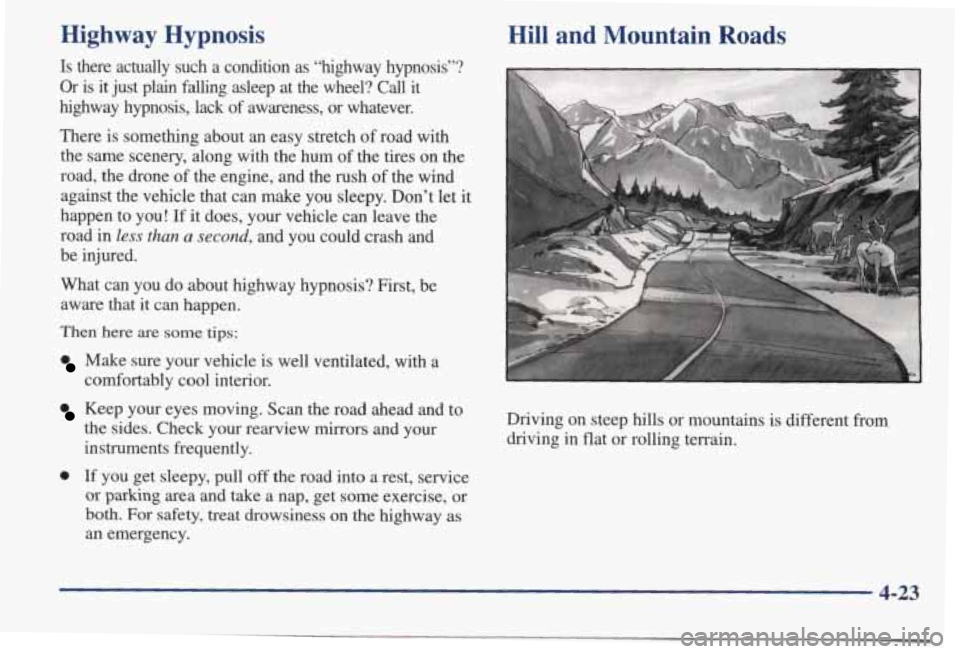
Highway Hypnosis
Is there actually such a condition as “highway hypnosis”?
Or is it just plain falling asleep at the wheel? Call it
highway hypnosis, lack
of awareness, or whatever.
There is something about an easy stretch
of road with
the same scenery, along with the hum
of the tires on the
road, the drone
of the engine, and the rush of the wind
against the vehicle that can make you sleepy. Don’t let it
happen to you!
If it does, your vehicle can leave the
road in
less than a second, and you could crash and
be injured.
What can you do about highway hypnosis? First, be aware that it can happen.
Then here are some tips:
Make sure your vehicle is well ventilated, with a
comfortably cool interior.
Keep your eyes moving. Scan the road ahead and to
the sides. Check your rearview mirrors and
your
instruments frequently.
0 If you get sleepy, pull off the road into a rest, service
or parking area and take a nap, get some exercise, or
both. For safety, treat drowsiness on the highway as
an emergency.
Hill and Mountain Roads
Driving on steep hills or mountains is different from
driving in flat or rolling terrain.
4-23
Page 377 of 395
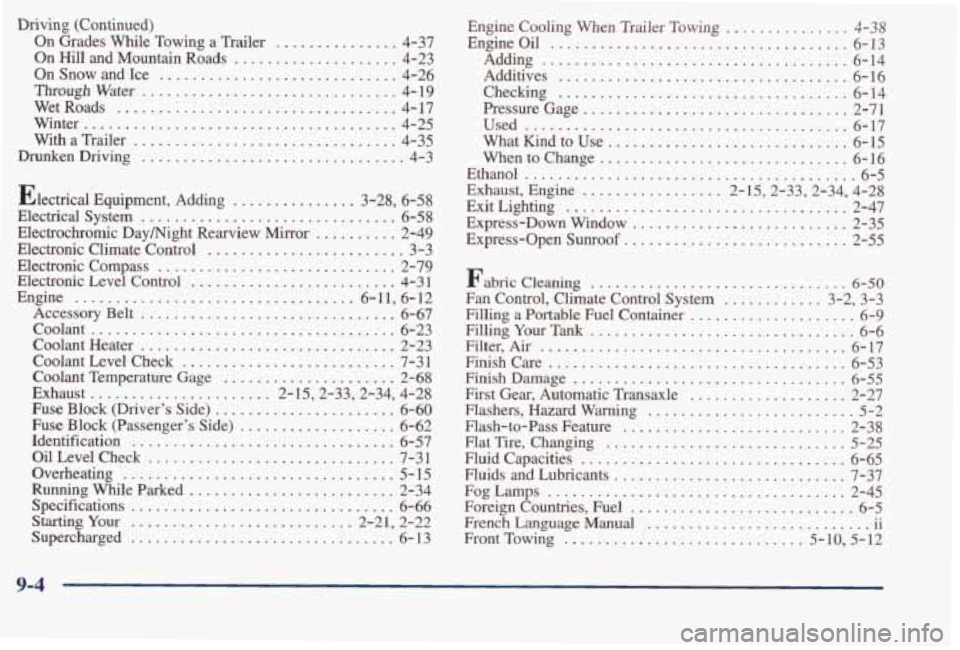
Driving (Continued) On Grades While Towing a Trailer
............... 4-37
On Hill and Mountain Roads
.................... 4-23
On Snow and Ice
............................. 4-26
ThrmrghWatm ............................... 4-19
WetRoads
.................................. 4-17
Winter
...................................... 4-25
With a Trailer
................................ 4-35
Drunken Driving
................................ 4-3
Electrical Equipment. Adding
............... 3.28. 6.58
Electrical System
............................... 6-58
Electrochromic Daymight Rearview Mirror
.......... 2-49
Electronic Climate Control
........................ 3-3
Electronic Compass
............................. 2-79
Electronic Level Control
......................... 4-31
Engine .................................. 6.11. 6.12
Accessory Belt
............................... 6-67
Coolant
..................................... 6-23
Coolant Heater
............................... 2-23
Coolant Level Check
.......................... 7-31
Coolant Temperature Gage
..................... 2-68
Exhaust ...................... 2-15.2-33.2-34. 4-28
Fuse Block (Driver’s Side)
...................... 6-60
Fuse Block (Passenger’s Side) ................... 6-62
Oil Level Check .............................. 7-31
Overheating
................................. 5- 15
Running While Parked ......................... 2-34
Specifications
................................ 6-66
StartingYour ...........................2-21. 2-22
Identification
................................ 6-57
Supercharged
................................ 6-13 Engine Cooling When Trailer
Towing ............... 4-38
Engine Oil .................................... 6-13
Adding
..................................... 6-14
Pressure Gage
................................ 2-71
What
Kind to Use ............................. 6-15
When to Change
.............................. 6-16
Ethanol
........................................ 6-5
Exhaust. Engine
................. 2-15.2-33.2-34. 4-28
Express-Down Window
.......................... 2-35
Express-Open
Sunroof ........................... 2-55
Additives
................................... 6-16
Checking ................................... 6-14
Used ....................................... 6-17
ExitLighting
.................................. 2-47
Fabric Cleaning ............................... 6-50
Fan Control. Climate Control System ............ 3-2. 3-3
Filling a Portable Fuel Container
.................... 6-9
FillingYourTank
................................ 6-6
Finishcare
.................................... 6-53
First Gear, Automatic Transaxle
................... 2-27
Flashers.
Hazard Warning ......................... 5-2
Flash-to-Pass Feature ........................... 2-38
Flat Tire. Changing ............................. 5-25
Fluid Capacities
................................ 6-65
Fluids and Lubricants
............................ 7-37
Fog Lamps .................................... 2-45
Foreign Countries, Fuel
........................... 6-5
French Language
Manual ........................... ii
Front Towing
............................. 5-10. 5-12
Filter.
Air ..................................... 6-17
FinishDamage
................................. 6-55
9-4
Page 378 of 395
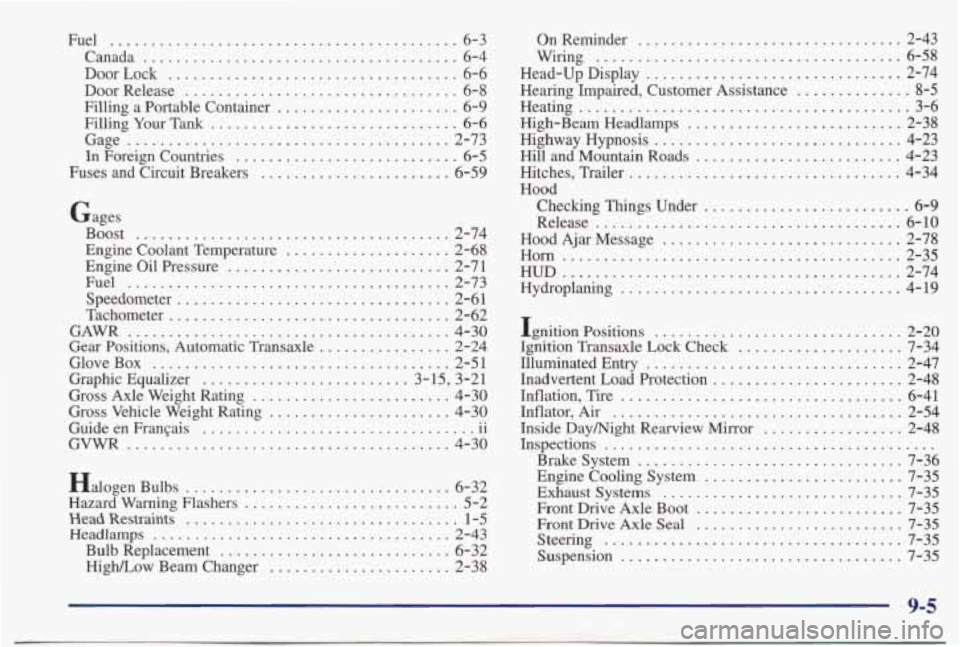
Fuel .......................................... 6-3
Canada
...................................... 6-4
Door Lock
................................... 6-6
Door Release
................................. 6-8
Filling a Portable Container
...................... 6-9
Filling
Your Tank .............................. 6-6
Gage ....................................... 2-73
In Foreign Countries ........................... 6-5
Fuses and Circuit Breakers ....................... 6-59
Gages Boost
.................................... 2-74
Engine Coolant Temperature
.................... 2-68
Engine Oil Pressure
........................... 2-71
Fuel
....................................... 2-73
Speedometer
................................. 2-6 1
Tachometer
.................................. 2-62
GAWR
....................................... 4-30
Gear Positions, Automatic Transaxle
................ 2-24
GloveBox
.................................... 2-51
Graphic Equalizer
......................... 3-15, 3-21
Gross Axle Weight Rating
........................ 4-30
Gross Vehicle Weight Rating
...................... 4-30
Guide en Franpis 11
GVWR ......... .................... 4-30
.. .................................
Halogen Bulbs ................................ 6-32 ...
Haadwarning Flashers .......................... 5-2
Head Restraints ................................. 1-5
Headlamps
.................................... 2-43
Bulb Replacement
............................ 6-32
High/Low Beam Changer
...................... 2-38 On Reminder
................................ 2-43
Wiring
..................................... 6-58
Head-Up Display
............................... 2-74
Hearing Impaired. Customer Assistance
.............. 8-5
High-Beam Headlamps .......................... 2-38
Highway Hypnosis
.............................. 4-23
Hill and Mountain Roads ......................... 4-23
Hitches. Trailer ................................. 4-34
Hood Checking Things Under
......................... 6-9
Release
..................................... 6-10
Hood Ajar Message
............................. 2-78
Horn
......................................... 2-35
HUD ......................................... 2-74
Hydroplaning
.... ..................... 4-19
Ignition Positions
.............................. 2-20
Ignition Transaxle Lock Check
.................... 7-34
Illuminated Entry
............................... 2-47
Inadvertent Load Protection
....................... 2-48
Inflation. Tire
.................................. 6-41
Inflator. Air
................................... 2-54
Inside Daymight Rearview
Mirror ................. 2-48
Brakesystem ................................ 7-36
Engine Cooling System
........................ 7-35
Exhaust Systems
............................. 7-35
Front Drive Axle Boot
......................... 7-35
FrontDriveAxleSeal
......................... 7-35
Steering
.................................... 7-35
Suspension
.................................. 7-35
Heating
........................................ 3-6
Inspections
........................................
9-5
Page 380 of 395

Low Washer Fluid Light ......................... 2-72
Lubricants and Fluids
............................ 7-37
Lubrication Service. Body
........................ 7-32
Lumbar Controls
................................ 1-3
Magnasteer
................................ 4. 10
Maintenance Record
............................ 7-39
Maintenance Schedule
............................ 7- 1
Long Tripmghway Definition ................... 7-6
Long Trip/Highway Intervals
..................... 7-6
Owner Checks and Services
..................... 7-31
Periodic Maintenance Inspections
................ 7-35
Recommended Fluids and Lubricants
............. 7-37
Scheduled Maintenance Services
.................. 7-4
Short Trip/City Definition
....................... 7-5
Short Trip/City Intervals
........................ 7-5
Maintenance. Underbody ......................... 6-55
Maintenance When Trailer Towing
................. 4-38
Malfunction Indicator Lamp
...................... 2-68
Manual Front Seat
............................... 1-2
Manual Rgmote Control Mirror
.................... 2-49
Maxifuse Relay Center
......................... 6-59
Methanol
...................................... 6-5
Mirrors
....................................... 2-48
Convex Outside
.............................. 2-50
Electrochromic Daymight Rearview .............. 2-49
Inside Daymight Rearview
..................... 2-48
Manual Remote Control ........................ 2-49
Power Remote Control
......................... 2-50
Visorvanity ................................. 2-53
MMT ......................................... 6-4
Mountain Roads
................................ 4-23
Maintenance. Normal Replacement Parts
............ 6-66
Net.
Convenience
.............................. 2-52
Neutral. Automatic Transaxle
..................... 2-25
New Vehicle Break-In
........................... 2-19
Night Vision ................................... 4-16
Normal Maintenance Replacement Parts
............. 6-66
Odometer
........ ............ ...... 2-61
Odometer. Trip
................................. 2-61
Off-RoadRecovery
............................. 4-12
Oil. Engine .................................... 6-13
Oil Level Warning Light
......................... 2-72
Oil. Supercharger ............................... 6-19
Overdrive. Automatic Transaxle
........ ...... 2-26
Overheating Engine
............................. 5-15
Owner Checks and Services
....................... 7-31
Owner Publications. Ordering
..................... 8-13
Paint Spotting. Chemical ........................ 6-55
Park Automatic
Transaxle .......................... 2-24
Shifting Into ................................. 2-29
Shiftingoutof
............................... 2-32
AtNight .................................... 2-15
Brake
...................................... 2-28
Brake Mechanism Check
....................... 7-34
Lots
....................................... 2-16
Over Things That
Burn ........................ 2-33
WithaTrailer
................................ 4-37
Passing
..&.................................... 4-13
PASS-Key 11 ................................. 2-18
Performance Shifting
............................ 2-27
Periodic Maintenance Inspections
.................. 7-35
Parking
9-7